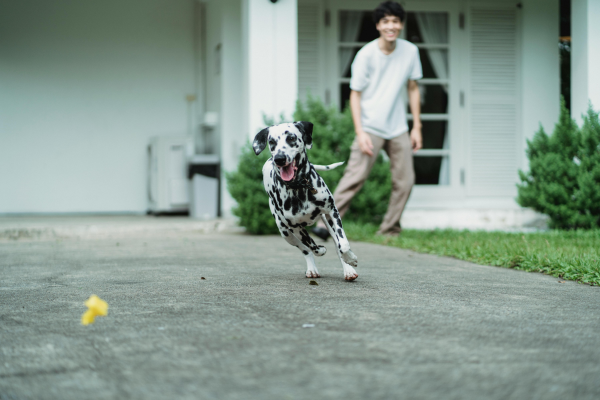Service dogs perform life-changing work every single day. Whether they’re guiding, alerting, retrieving, or supporting mobility, these incredible partners rely on their bodies to carry out complex and physically demanding tasks. Just like human athletes, service dogs need consistent fitness and conditioning to stay strong, prevent injury, and extend their working years.
At Justice Speaks, we believe that advocacy starts with understanding. By educating the public about what goes into maintaining a service dog’s health and strength, we can help create a world where handlers and the dogs who support them are set up for lasting success.
Why Fitness Matters for Service Dogs
A well-conditioned service dog isn’t just “fit”; they’re capable, confident, and better equipped to perform their tasks safely. From opening doors and retrieving items to detecting medical changes and guiding their handlers across busy intersections, these dogs rely on muscle control, endurance, and balance every day.
Without regular conditioning, service dogs are at higher risk of joint strain, back issues, and fatigue. Over time, that can shorten their working lifespan and limit their handler’s independence. A structured fitness routine can help strengthen key muscle groups, maintain flexibility, and support joint health. This will ensure service dogs can continue doing what they do best, longer.
Safe and Effective Fitness Routines
Not all exercise is created equal, and that goes for humans and animals. While every service dog’s exercise routine should be tailored to their breed, size, and role, some safe, general practices benefit almost all working dogs.
1. Daily Walks and Endurance Training
Steady-paced walks are the foundation of any canine fitness program. These walks keep muscles warm and improve cardiovascular endurance. Gradually increasing the length and difficulty of walks, such as incorporating walks on gentle hills or varied terrain, helps build strength while reducing boredom.
2. Core Strengthening Exercises
A strong core is essential for balance and injury prevention. Activities like “sit-to-stand” repetitions, controlled paw lifts, or walking slowly over a low balance board engage abdominal and back muscles that stabilize movement during tasks.
3. Mobility and Flexibility Work
Gentle stretching and range-of-motion exercises help keep joints limber. Simple activities such as figure-eight walking, weaving around cones, or stepping over low poles support flexibility and coordination.
4. Strength Training for Service Dogs
Just as humans use resistance to build strength, dogs can benefit from structured strengthening exercises. Controlled uphill walking, light pulling with a harness, or water-based exercise develops muscle safely while minimizing stress on joints.
5. Mental Fitness
Physical conditioning is only part of the equation. Mental stimulation, like problem-solving games, scent detection, or practicing training tasks, can help keep service dogs sharp and engaged. A fit mind prevents burnout and reinforces confidence.
Every session should be low-impact, positive, and rewarding. Ensuring the dog enjoys the process as much as the result is critical.
The Role of the Handler
Fitness and conditioning aren’t just about the service dog; they’re about teamwork. Handlers play a crucial role in monitoring their dog’s health, adjusting routines, and recognizing signs of fatigue or discomfort.
Building this awareness strengthens the bond between dog and handler, creating a partnership based on mutual trust and care. Regular vet checkups, professional conditioning assessments, and proactive rest days all contribute to a healthy and sustainable life.
At Justice Speaks, we often remind the public that service dogs are working athletes. Their fitness isn’t cosmetic, it’s functional. When we see a handler walking their dog off-duty or taking time for play, it’s not just recreation. It’s essential maintenance for the vital tasks these dogs perform every day.
Teaching Respect and Understanding
One of the best ways to support service dog teams is through education, especially among young people. Justice Speaks offers school programming designed to teach students of all ages about service dog care, accessibility, and respect.
During our visits, students learn about how dogs are trained for service, how to act around a working dog, and why rest, exercise, and focus time are so important. We often demonstrate basic conditioning activities to show just how athletic and skilled these animals are.
These experiences leave lasting impressions, helping children see service dogs not as pets to play with, but as professionals who deserve space, respect, and admiration. By supporting our school programs, you can help create communities that understand and protect the rights of people with disabilities and their service dogs.
Strong Bodies and Strong Bonds
A service dog’s strength is much more than just physical. It’s emotional, mental, and deeply connected to their partnership with their handler. Through proper fitness and conditioning, these dogs stay healthy, focused, and ready to serve with confidence and joy.
At Justice Speaks, we’re proud to advocate for the dogs who work tirelessly for others. By understanding what it takes to keep them healthy and happy, we can all play a part in protecting their well-being and the independence of the people who rely on them.
How You Can Help Service Dogs
Service Dogs dedicate their lives to helping others. You can return the favor by helping us continue to educate, advocate, and empower them.
- Donate to Justice Speaks to fund outreach, advocacy, and school education programs across communities.
- Sponsor a classroom visit to help us bring hands-on demonstrations and disability awareness to students.
- Share our mission on social media to spread awareness about service dog health, training, and rights.
Every dollar supports our efforts to make public spaces more accessible and inclusive for service dog teams everywhere. Learn more about our mission, donate, or invite us to your school today! Together, we can strengthen the bond between service dogs and the communities they serve.


